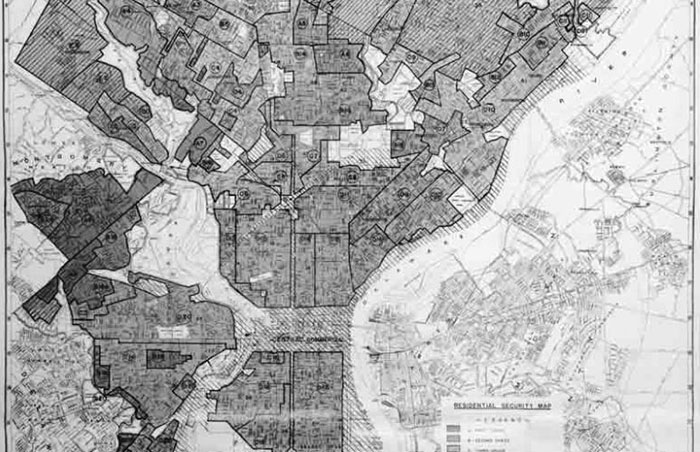Redlining, the first time: In 1934, in response to the Great Depression, the Federal Government created the Federal Housing Administration. With low down payments, extended terms and affordable interest rates, the FHA backed mortgages which ignited wealth growth for white people through homeownership.
 On the other hand, the FHA drew red lines around predominantly black neighborhoods and refused to back loans in these typically inner-city areas, which struggled as a result. Whites living near blacks fled, not because blacks are bad neighbors but because property values drop when there is no mortgage financing available. Between 1934 and 1968, 98 percent of the mortgages insured by the federal government went to whites.
On the other hand, the FHA drew red lines around predominantly black neighborhoods and refused to back loans in these typically inner-city areas, which struggled as a result. Whites living near blacks fled, not because blacks are bad neighbors but because property values drop when there is no mortgage financing available. Between 1934 and 1968, 98 percent of the mortgages insured by the federal government went to whites.
Redlining, this time: In 2010, in response to the Great Recession, the Federal Government created Dodd-Frank. This consumer protection legislation mandated untenably low caps on the fees which lenders could charge to originate loans on $50,000-and-under homes. In response, most lenders set minimum loan amounts of $50,000. As a consequence, lenders refuse to originate loans in predominantly minority and typically inner-city neighborhoods where home values are
often below $50,000. Thus, as the rest of the country’s home markets rebound, America’s poorest communities sink further and further underwater.
Between the third quarter of 2015 and the first quarter of 2016, RealtyTrac found an overall decline in the number of homeowners who are seriously underwater on their homes. Seriously underwater means that at least 25 percent more is owed on the mortgage than the house is worth. In fact, the number of seriously underwater homes dropped in every price category except one: the number of seriously underwater $50,000-and-under homes increased by 13.4 percent.
What’s more, while about 5.7 percent of people with homes valued at $1 million and up are seriously underwater, the problem is nearly ten times that size for homeowners in $50,000-and-under homes. For these homeowners, whose home is often their only financial asset, 53 percent are seriously underwater. This extraordinary divergence is a byproduct of the growing wealth- and income-gaps in America and a product of Dodd-Frank.

“Thanks to Dodd-Frank,” a 2014 report by the financial services committee of the US House of Representatives stated, “it is now harder for low- and moderate-income Americans to buy a home. Dodd Frank has been the wrong remedy, adding incomprehensible complexity to incomprehensible complexity.”
Part of Dodd-Frank was meant to prevent one form of predatory lending, where a mortgage broker may lure an unsuspecting borrower into an unsustainable mortgage just to collect excessive fees. To protect against this, there is wisdom in a cap on the fees that mortgage lenders and brokers can charge. However, Dodd-Frank’s cap is typically defined as a percentage of the loan amount, minus several fixed fees, the costs of which are often the same for a $30,000 mortgage as a $300,000 mortgage.
What that means is that brokers and lenders effectively get paid considerably less to do a small mortgage than to do a big one. Look at the numbers: For loans of under $50,000, the cap is five percent. On the surface, this may appear reasonable. But five percent on a $40,000 loan equals $2,000. Once fees for processing, document preparation, lock-in fee, and other lender services are charged against the $2,000, maybe $1,000 is left for points. Lenders and their agents share the points, so the potential to generate a few hundred dollars each is so unattractive that most lenders choose to not originate loans of under $50,000.
On the other hand, if the same loan agent spends time on a loan of over $100,000, the cap is three percent. A lower percentage, but once the fees are deducted, the agent is likely to make at least twice as much for the same effort. (Remember, the fixed fees don’t typically vary in size with the amount of the mortgage.)
As a result, financing a home in America’s poorest neighborhoods has become challenging, and sometimes impossible. This has pushed prices further downwards, as aspiring homebuyers are encouraged to purchase in slightly higher cost neighborhoods, so they can get a mortgage that’s above the minimum. That leaves homes in the poorest neighborhoods to be sold for cash, which is out of reach for most owner-occupants. Thus, low-priced homes frequently get bought by investors, who then rent out the homes.
The result? As lenders abandon our country’s poorest neighborhoods, residents are renting instead of buying, eliminating the potential to build wealth through home ownership and draining the pride often evident in communities with high homeownership rates.
Dodd-Frank represented a knee-jerk reaction to the excessive fees charged during the predatory subprime days. The flow of mortgage capital into these neighborhoods was not cleaned up by the legislation, it was strangled.
The solution: higher fees for lenders. Really. It may seem paradoxical to push legislators to allow lenders to charge higher fees in order to stabilize our country’s most challenged neighborhoods. However, that is the solution needed to erase America’s new red lines.
Tags: AHP, American dream, American Homeowner Preservation, Community, Distressed Mortgages, failure, real estate

 440 S LaSalle Street, Suite 1110, Chicago,IL 60605
440 S LaSalle Street, Suite 1110, Chicago,IL 60605




